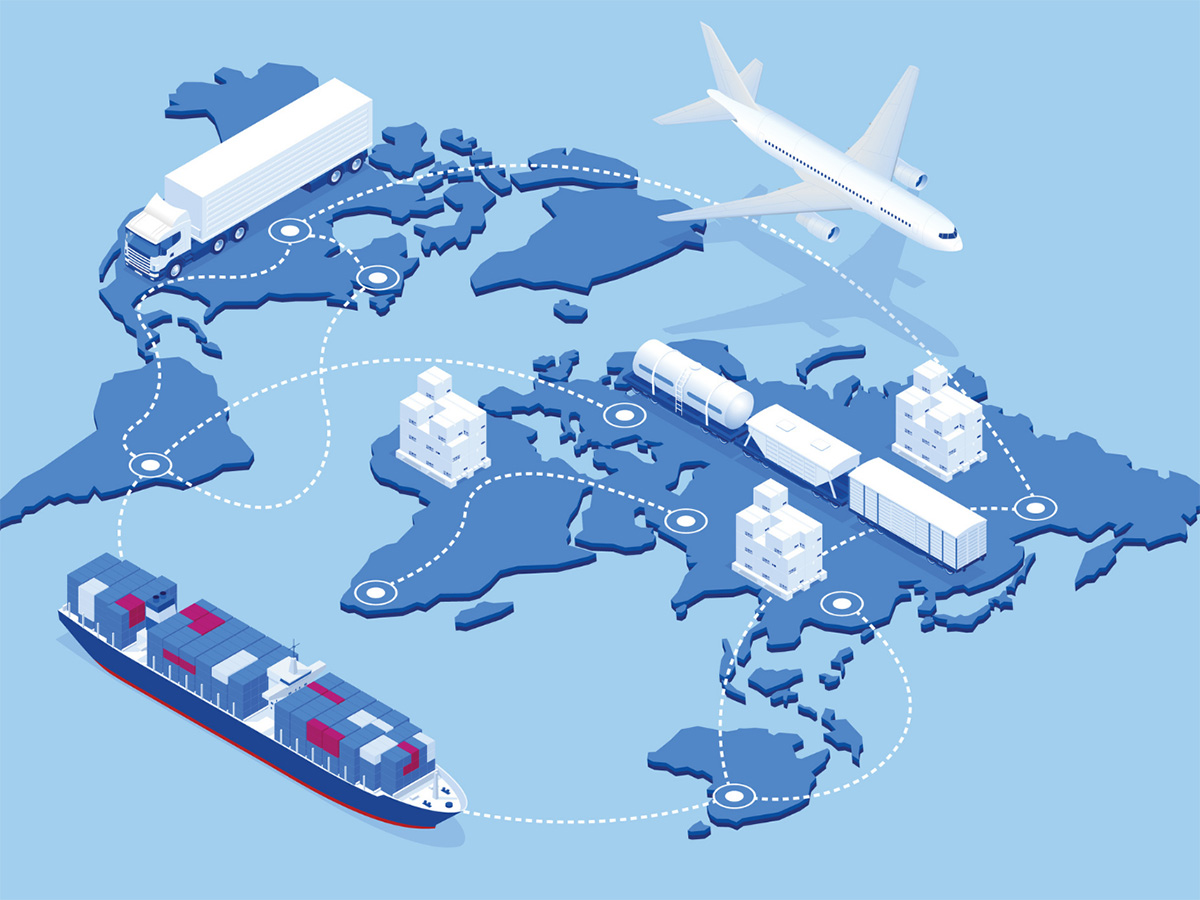

Finance
What Is The Digital Supply Chain?
Published: October 19, 2023
Learn how finance plays a crucial role in the digital supply chain, optimizing operations, streamlining processes, and driving business growth.
(Many of the links in this article redirect to a specific reviewed product. Your purchase of these products through affiliate links helps to generate commission for LiveWell, at no extra cost. Learn more)
Table of Contents
Introduction
In today’s fast-paced business landscape, companies across industries are constantly seeking innovative ways to streamline their operations, increase efficiency, and gain a competitive edge. One area that has undergone significant transformation in recent years is the supply chain.
The traditional supply chain, based on physical processes and manual operations, is being revolutionized by the emergence of the digital supply chain. Powered by advances in technology, the digital supply chain leverages automation, connectivity, and data analytics to optimize the flow of goods, information, and services from suppliers to customers.
The digital supply chain encompasses a wide range of interconnected systems and technologies that enable real-time visibility, seamless collaboration, and intelligent decision-making. With the ability to capture and analyze vast amounts of data, companies can gain valuable insights into their supply chain processes, improve forecasting accuracy, and enhance customer satisfaction.
This article aims to provide a comprehensive overview of the digital supply chain, exploring its key components, benefits, challenges, and strategies for successful implementation. Additionally, we will delve into future trends and how they are shaping the landscape of supply chain management.
Understanding the Digital Supply Chain
The digital supply chain is a technology-driven approach to managing the flow of goods, information, and services from the point of origin to the end customer. It encompasses digital technologies, automation, and data analytics to enable seamless collaboration, efficient operations, and improved decision-making.
At the core of the digital supply chain is the digitization of key processes and activities. This involves capturing and converting physical data into digital formats, making it easily accessible and analyzable. By doing so, companies can gain real-time visibility into their supply chain, enabling them to proactively identify bottlenecks, predict demand fluctuations, and optimize inventory levels.
One of the fundamental components of the digital supply chain is connectivity. With the advent of IoT (Internet of Things) and the proliferation of sensors and devices, almost every aspect of the supply chain can be interconnected. This connectivity allows for real-time tracking of shipments, monitoring of inventory levels, and capturing of key performance indicators.
Data analytics also plays a crucial role in the digital supply chain. By analyzing large volumes of data, companies can uncover trends, patterns, and insights that can drive informed decision-making. Predictive analytics can help optimize transportation routes, demand forecasting, and inventory management, reducing costs and improving efficiency.
Furthermore, automation is a key enabler of the digital supply chain. Robotic process automation (RPA) and machine learning algorithms can automate repetitive tasks, such as order processing, invoice reconciliation, and inventory replenishment. This not only improves accuracy but also frees up resources to focus on more strategic activities.
The digital supply chain also promotes collaboration among different stakeholders. By connecting suppliers, manufacturers, distributors, and retailers on a common platform, companies can share real-time information, coordinate activities, and respond to changes in demand quickly. This level of collaboration leads to improved customer satisfaction and supply chain resilience.
In summary, the digital supply chain leverages technology, connectivity, and data analytics to digitize processes, enhance visibility, and enable informed decision-making. By embracing the digital transformation, businesses can gain a competitive advantage, adapt to rapidly changing market conditions, and deliver a superior customer experience.
Key Components of a Digital Supply Chain
The digital supply chain consists of several key components that work together to enable efficient and effective supply chain management. These components leverage technology and data to streamline processes and optimize the flow of goods and information. Here are some of the key components of a digital supply chain:
- Supply Chain Visibility: Real-time visibility is critical for an effective digital supply chain. This component enables companies to track the movement of goods, monitor inventory levels, and identify potential disruptions or delays. With the help of IoT devices, RFID tags, and GPS tracking, companies can have complete end-to-end visibility into their supply chain.
- Data Analytics: Data analytics plays a crucial role in the digital supply chain. By analyzing large volumes of data, companies can gain valuable insights and make data-driven decisions. Predictive analytics can help optimize inventory levels, anticipate demand fluctuations, and improve overall supply chain efficiency.
- Automation: Automation is a key component of the digital supply chain. It involves the use of technologies such as robotics, AI, and machine learning to automate repetitive and manual tasks. Automation can improve accuracy, speed up processes, and reduce costs in areas such as order processing, warehouse operations, and transportation management.
- Collaboration and Connectivity: Collaboration and connectivity are essential for a digital supply chain. By connecting all stakeholders, including suppliers, manufacturers, distributors, and retailers, on a common platform, companies can share information in real-time and collaborate more effectively. This leads to better coordination, faster decision-making, and improved overall supply chain performance.
- Demand Planning and Forecasting: Accurate demand planning and forecasting are critical components of a digital supply chain. With the help of advanced analytics, companies can analyze historical data, market trends, and consumer behavior to forecast demand more accurately. This enables better inventory management, reduced stockouts, and improved customer service.
- Supplier Relationship Management: Managing supplier relationships is a key component of the digital supply chain. By leveraging technologies such as supplier portals and e-procurement systems, companies can improve communication, collaboration, and information sharing with their suppliers. This leads to better supplier performance, reduced lead times, and improved overall supply chain efficiency.
These are just some of the key components that make up a digital supply chain. By integrating these components and leveraging technology and data, companies can transform their supply chain into a more agile, efficient, and responsive system.
Benefits of Implementing a Digital Supply Chain
The implementation of a digital supply chain offers numerous benefits that can significantly enhance operational efficiency, customer satisfaction, and overall business performance. By leveraging technology, connectivity, and data analytics, companies can unlock the following advantages:
- Improved Visibility: One of the key benefits of a digital supply chain is enhanced visibility. Real-time tracking, monitoring, and reporting enable companies to have full visibility into the movement of goods, inventory levels, and key performance indicators. This heightened visibility allows for better decision-making, improved risk management, and increased responsiveness to customer demands.
- Enhanced Collaboration: The digital supply chain facilitates collaboration among different stakeholders. By connecting suppliers, manufacturers, distributors, and retailers on a common platform, companies can share real-time information, collaborate on forecasts, and coordinate activities seamlessly. This level of collaboration leads to improved communication, reduced lead times, and greater supply chain agility.
- Optimized Inventory Management: With real-time data and advanced analytics, companies can optimize their inventory management processes. By accurately forecasting demand, companies can avoid overstocking or stockouts, reducing carrying costs and improving cash flow. Furthermore, digital technologies such as RFID and IoT enable improved inventory tracking, ensuring accurate and timely inventory replenishment.
- Streamlined Operations: Automation is a key enabler of the digital supply chain. By automating repetitive tasks, such as order processing, invoice reconciliation, and shipment tracking, companies can streamline their operations, reduce errors, and save valuable time. This allows resources to be redirected towards more strategic activities, driving operational efficiency and productivity.
- Improved Customer Experience: The digital supply chain enables companies to deliver a superior customer experience. Real-time visibility into order status, accurate delivery estimates, and proactive communication enhance customer satisfaction and loyalty. Additionally, by leveraging data analytics, companies can gain insights into customer preferences and buying patterns, enabling personalized offerings and targeted marketing strategies.
- Increased Supply Chain Resilience: A digital supply chain is more resilient to disruptions. With real-time data and analytics, companies can proactively identify and mitigate risks, such as supplier disruptions, weather events, or transportation delays. By having alternative sourcing strategies and contingency plans, companies can ensure continuity of operations and minimize the impact of disruptions.
The benefits of implementing a digital supply chain are far-reaching and can positively impact various aspects of a company’s operations. From improved visibility and collaboration to optimized inventory management and enhanced customer experience, the digital supply chain provides a competitive edge in today’s dynamic business environment.
Challenges in Adopting a Digital Supply Chain
While the implementation of a digital supply chain offers significant benefits, it also presents several challenges that companies may encounter. Understanding and addressing these challenges is crucial for a successful adoption of the digital supply chain. Here are some common challenges:
- Data Quality and Integration: A major challenge in a digital supply chain is ensuring the quality, accuracy, and consistency of data. Companies must establish robust data governance processes and invest in data integration technologies to ensure seamless flow of information across different systems and stakeholders.
- Legacy Systems and Infrastructure: Many companies still rely on legacy systems and outdated infrastructure, which may not be compatible with the requirements of a digital supply chain. Upgrading or replacing these systems can be complex, costly, and time-consuming, requiring careful planning and execution.
- Change Management: Implementing a digital supply chain involves significant changes in processes, roles, and responsibilities. Resistance to change from employees and stakeholders can pose challenges. Clear communication, training programs, and change management strategies are essential to ensure smooth adoption and acceptance of the digital supply chain.
- Cybersecurity and Data Privacy: With increased connectivity and data exchange, cybersecurity and data privacy become critical concerns. Companies must invest in robust cybersecurity measures, such as encryption, firewalls, and access controls, to protect sensitive supply chain data from cyber threats and breaches.
- Talent and Skills Gap: The digital supply chain requires specialized skill sets, such as data analytics, automation, and technology expertise. Many companies face challenges in attracting and retaining talent with these skills. Training and development programs can help bridge the skills gap and ensure the workforce is equipped to leverage digital technologies effectively.
- Supplier and Partner Collaboration: Collaboration with suppliers and partners is a key component of a digital supply chain. However, aligning different systems, processes, and cultures can be challenging. Establishing clear expectations, effective communication channels, and mutually beneficial partnerships are critical for successful collaboration.
Addressing these challenges requires a holistic approach that involves technology, processes, and people. Companies must invest in scalable technology solutions, establish robust data management practices, and foster a culture of collaboration and continuous learning to overcome the challenges and reap the full benefits of a digital supply chain.
Strategies for Successful Digital Supply Chain Implementation
Implementing a digital supply chain can be a complex endeavor, but with careful planning and execution, companies can overcome challenges and ensure a successful transformation. Here are some key strategies to consider for a smooth and effective digital supply chain implementation:
- Define Clear Objectives: Start by clearly defining the objectives and desired outcomes of the digital supply chain implementation. Identify key performance indicators (KPIs) that will measure the success of the implementation and align them with the overall business goals.
- Create a Roadmap: Develop a well-defined roadmap that outlines the steps, milestones, and timelines for implementing the digital supply chain. Breaking down the implementation into specific phases can make the process more manageable and allow for incremental improvements.
- Invest in the Right Technology: Choose technology solutions that align with your specific supply chain needs and objectives. Consider factors such as scalability, integration capabilities, and ease of use. Engage with technology vendors or partners who have a proven track record in digital supply chain implementation.
- Ensure Data Readiness: Data is at the core of a digital supply chain. Ensure that your data is accurate, consistent, and of high quality. Clean up any existing data issues and establish data governance practices to maintain data integrity throughout the supply chain.
- Focus on Change Management: Recognize that implementing a digital supply chain involves significant changes in processes, roles, and responsibilities. Provide ample training and support to employees to help them adapt to the changes and embrace the digital tools and technologies. Communicate the benefits of the digital supply chain and involve employees in the implementation process.
- Collaborate with Partners: Engage with suppliers, customers, and other partners throughout the implementation process. Seek their input, involve them in the decision-making process, and develop mutually beneficial partnerships. Collaboration and integration across the supply chain ecosystem are vital for a successful digital supply chain.
- Measure and Optimize: Continuously measure and monitor the performance of the digital supply chain against the defined objectives and KPIs. Analyze the data collected and identify areas for improvement. Use the insights to make data-driven decisions and continuously optimize the supply chain processes.
Implementing a digital supply chain is not a one-time event but an ongoing journey. It requires a long-term commitment, continuous improvement, and adaptability to leverage emerging technologies and industry trends.
By following these strategies, companies can navigate the complexities of digital supply chain implementation and unlock the full potential of a more agile, efficient, and customer-centric supply chain.
Future Trends in the Digital Supply Chain
The digital supply chain landscape is continuously evolving, driven by technological advancements and changing market dynamics. Staying ahead of these future trends is critical for companies to remain competitive and thrive in the ever-changing business environment. Here are some key trends that are shaping the future of the digital supply chain:
- Internet of Things (IoT): IoT is revolutionizing supply chain management by providing real-time connectivity and data sharing across various devices and sensors. IoT devices enable accurate tracking, monitoring, and analysis of assets and shipments, contributing to improved visibility, reduced inefficiencies, and enhanced decision-making capabilities.
- Artificial Intelligence (AI) and Machine Learning (ML): AI and ML are driving significant advancements in the digital supply chain. These technologies enable predictive analytics, demand forecasting, and optimization of supply chain operations. AI-powered chatbots and virtual assistants are also being utilized to enhance customer service and provide real-time support.
- Blockchain Technology: Blockchain technology is gaining traction in the supply chain industry due to its decentralized, secure, and transparent nature. By utilizing blockchain, companies can create immutable records of transactions, improve traceability, and enhance trust and collaboration within supply chain networks.
- Robotics and Automation: Robotics and automation are becoming increasingly prevalent in supply chain operations. Warehouse robots, autonomous vehicles, and drones are being utilized for tasks such as picking, packing, inventory management, and transportation. Automation not only improves operational efficiency but also reduces human errors and increases safety.
- Advanced Analytics and Big Data: The ability to collect and analyze massive volumes of data is becoming paramount in the digital supply chain. Advanced analytics techniques, such as machine learning and data visualization, enable companies to extract actionable insights from their data. This helps optimize supply chain processes, mitigate risks, and unlock new growth opportunities.
- Sustainability and Green Initiatives: The digital supply chain is increasingly focused on sustainability and environmental impact. Companies are adopting eco-friendly practices, optimizing transportation routes, reducing carbon emissions, and utilizing renewable energy sources. Consumers are also placing greater importance on sustainable and ethical supply chain practices.
- Omni-Channel and E-commerce: The rise of e-commerce and the growing demand for seamless shopping experiences are driving the need for an omni-channel supply chain. Companies are integrating their online and offline channels, focusing on inventory visibility, order management, and fast fulfillment. The digital supply chain is evolving to meet the demands of the dynamic e-commerce landscape.
These future trends indicate a shift towards more connected, data-driven, and sustainable supply chain practices. Embracing these advancements can help companies stay agile, adapt to customer expectations, and gain a competitive advantage in the digital era.
Conclusion
The digital supply chain represents a transformative shift in how businesses manage their supply chain operations. By leveraging technology, connectivity, and data analytics, companies can streamline processes, optimize efficiency, and enhance customer satisfaction. From supply chain visibility and automation to collaboration and data-driven decision-making, the digital supply chain offers numerous benefits that can drive business growth and success in today’s dynamic marketplace.
However, the adoption of a digital supply chain is not without its challenges. Companies need to address issues such as data quality, legacy systems, change management, cybersecurity, and talent gaps to ensure a successful implementation. By overcoming these challenges and following the strategies outlined in this article, businesses can navigate the complexities and reap the rewards of a digital supply chain.
Looking ahead, future trends such as IoT, AI, blockchain, robotics, and sustainability will continue to shape the digital supply chain landscape. Embracing these technological advancements and staying ahead of market trends is crucial for companies to remain competitive and meet evolving customer expectations.
In conclusion, the digital supply chain presents a significant opportunity for businesses to transform their operations, gain a competitive edge, and meet the demands of the modern business landscape. By harnessing the power of technology, collaboration, and data analytics, companies can build resilient, efficient, and customer-centric supply chains, driving their success in the digital era.














